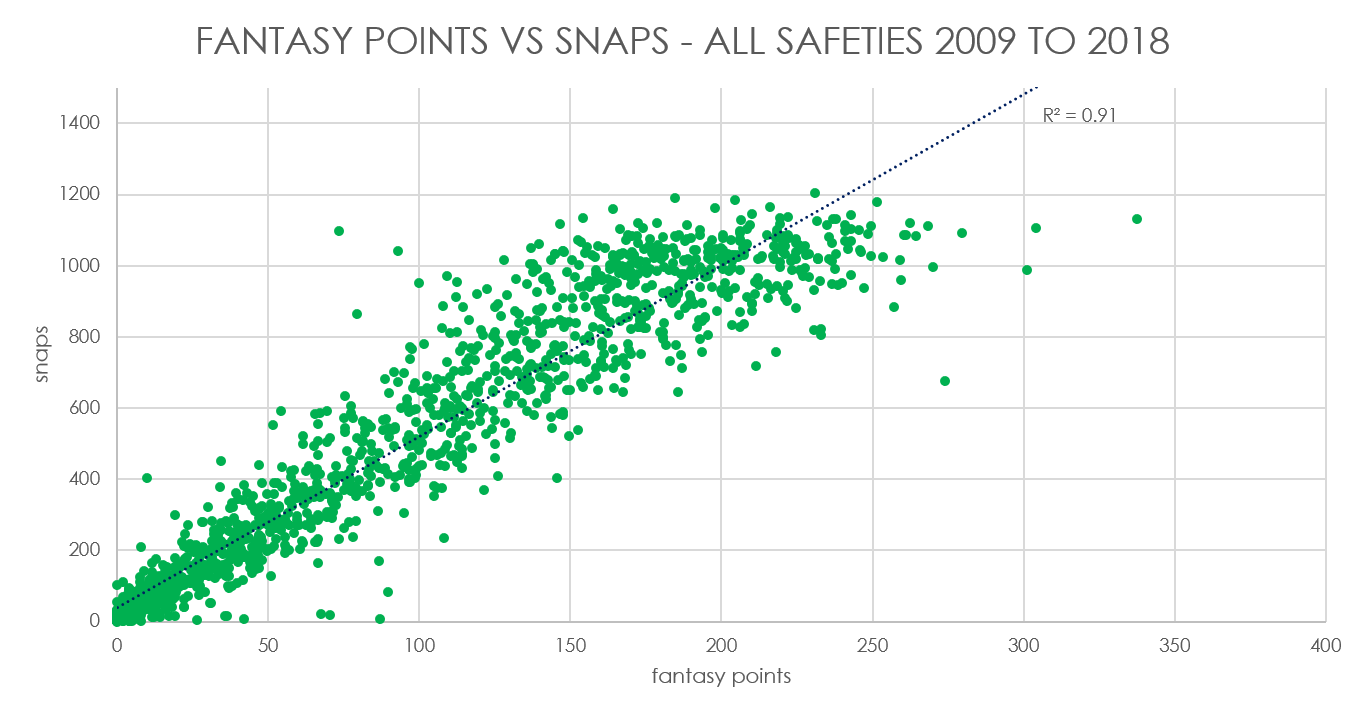Doing it Again: Seasonal Scoring in Safeties
As is often stated in my articles, safety is the most interesting position in football. They are the most variable and interesting players on the field. But generally, their value in IDP values is tough to gauge. The big-name players are often treated like rock stars (good luck trying to trade for Landon Collins) even though the advantage they offer against other players is generally very low due to the large supply of them.
That value imbalance is a matter for another day though. What I wanted to touch on today was how safeties fare from season to season. Are the same players consistently productive in IDP terms?
To do that, we need to talk in terms of fantasy scoring instead of just base statistics – the reason being we need to get a unified view of their productivity. We know that unusually high interception totals can boost a safety to the top of the charts (hello Jairus Byrd, Kevin Byard and Micah Hyde) and that is a key part of why players vary from year to year.
To try and keep this fairly standard, I’ve used base scoring from the famous NPLB (No Position Left Behind) which looks like this:

I’ve left out tackles for loss, return yardage and all defensive TDs. Those stats are so unpredictable they’re essentially random and shouldn’t form part of any meaningful work on understanding repeatability in football. The only reason they’d be included is if someone wanted to argue that certain players have consistently done well with those stats – and that’s just flat out untrue.
[am4show have=’g1;’ guest_error=’sub_message’ user_error=’sub_message’ ]
I then applied this scoring to the last ten years of safety statistics which gave me a fantasy points total for all the players in that time frame. Here’s the top ten from each year, color-coded with their scores.

Reshad Jones in 2015 was pretty great, wasn’t he? He played 1,130 snaps that year as Joe Philbin’s inert and inept offense failed to hold the ball. He also managed five interceptions, which is an excellent number.
The next thing you’ll notice is that in those ten years, no player was the top safety more than once. Not one. Hold on to that thought for now. Here’s the same chart but all players marked in green are those who were in the top 12 the year before.

There have only been 24 instances in the last nine years (two to three per season) of a top-12 safety being in the top 12 the year after. It’s far more likely for top 12 players to drop out of that range in fact. Just last season, only one player (Jordan Poyer) managed to stay in the top 12 from 2017. One.
Here’s the same chart but expanded to the top 24 safeties each season. The standard for IDP leagues is starting two per team in a 12-team league so this represents the best shot at what a starting safety is. It’s worth noting that your own league scoring may well be very different from this. Scoring is different and of course, this does not include some stat categories.

There have been 86 repeat top-24 players in nine years. An average of just under ten per year. So out of the ‘starting quality’ safeties each season, about 42% of them repeat and 58% are new each year. It’s more likely than not for your starting safety from 2018 will not be worthy of that title in 2019.
Now we’ve established that the turnover rate for safeties is high, there are a couple of questions: why is it so high? And how we can we take advantage of this?
The reason for it is simple. Safety scoring is first and foremost about volume and secondly about usage. Volume varies wildly because it’s mostly affected by injuries and offense. Players get hurt a lot. About two-thirds of the week one 2018 starting safeties missed at least a game. When the injury rate is so high, it’s tough to stay healthy multiple seasons in a row.
For those of you doubting the link between volume and points, here’s a chart showing fantasy points vs playing time for this period:

Usage is determined by coaching and we all know the shelf-life of coaches in the NFL is short. When you factor in coordinators and positional coaches, it’s no wonder there’s such high seasonal variance. Antoine Bethea is a great example. He’s been the most consistent IDP scoring safety of this period but in 2017 when he was asked to play deep, he scored poorly. This sort of thing happens all the time.
Big plays were mentioned beforehand too and those are not sticky across time. The likes of Kevin Byard can play just as well in coverage but have very different pick totals because they are down to quarterbacking more than the defender. Ultimately, it doesn’t matter. It is what it is. Safeties tend to not score reliably across seasons.
In terms of taking advantage then, it’s really pretty simple – don’t invest heavily into safeties. Don’t take them early in start-ups. Don’t pick them unless you absolutely have to in rookie drafts. Don’t trade for them.
It can often be tempting to go after a safety so you can lock the position down and not have to worry about it but we’ve seen that that sort of reliability is basically non-existent. Let your league-mates pay heavily for Landon Collins or Keanu Neal while you quietly go about smartly picking up short-term solutions who are in a good position right now. Once you accept you can’t rely on a long-term starter, it means you can take advantage of the age discount and give yourself fully to the task of finding waiver-wire darlings. Check in here at DLF in-season and we’ll ensure your back is covered for that.
The one exception to this is very large starting leagues – there are more and more 32-team leagues with single copies of players and for those, you will need to make sure you have viable options. But even there you should be focusing on finding high-volume players rather than investing in “young studs”.
It’s an enormous shame that safety isn’t a more valuable position in FF. Experimenting with leagues that start three or even four of them each week or bestball scoring is well worth it as they both tend to reward owning better players. But in your standard leagues now, you’ve got a good idea of how to attack the position.
[/am4show]
- Ten IDP Fantasy Football Stats You Need to Know after Week 16 - December 29, 2023
- Ten IDP Fantasy Football Stats You Need to Know after Week 15 - December 22, 2023
- Ten IDP Fantasy Football Stats You Need to Know after Week 14 - December 14, 2023


































































